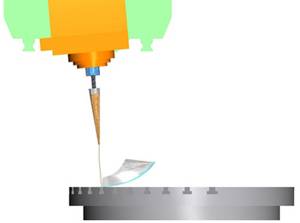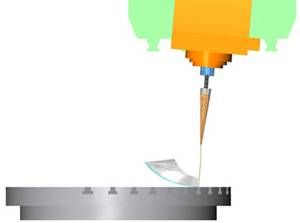 Multiaxis Posting
Multiaxis Posting
Introduction
This topic will explain the Multiaxis Posting page of the CAM Defaults Current Settings dialog, will explain how to access it, the options found in it, and will provide links to related topics.
Multiaxis Posting
The Multiaxis Posting page of the CAM Defaults Current Settings dialog box allows you to set the multiaxis posting settings for the machine selected on the Machine Parameters page. These multiaxis posting settings will be used when that machine is selected for a job unless otherwise specified in the Job Current Settings.
Navigation
To access the Multiaxis Posting page:
- In the CAM Tree Manager, right click CAM Defaults and select Current Settings.
The Current Settings dialog appears. - In the tree on the left, select Multiaxis Posting.
Parameters
Angle Pair
For many 5-axis machines there are two possible solutions to any point in a toolpath. The solution here refers to the angles used for each rotational axis. The following images show a part with the two possible Angle Pair solutions (this is the tool orientation for the toolpath starting point). The tool orientation to the part is the same in each situation; however, the table is rotated 180 degrees. The Angle Pair options control which solution is used. The purpose of the Auto Angle Pair is to use the solution that creates the least amount of tool-axis orientation change from the previous toolpath position. Keep in mind that some machines can't use both pairs based on rotational limits.
|
Two Solutions |
|
|
|
|
There are two main ways to set the Angle Pair settings: Automatic Angle Pair or Manual Angle Pair. These options are explained next.
![]() Automatic Angle Pair
Automatic Angle Pair
When the Automatic Angle Pair option is selected, the following parameters become available.
-
 Select
Among Solutions
Select
Among SolutionsWhen selecting this option, the software attempts to use the angle pair that provides the least amount of machine movement (from the start of the toolpath or previous operation). You can select First Solution and allow the software to calculate the angles. If this setting does not provide the desired results, you can change it to Other Solution to use the other possible angle pair values.
- First
Solution - sets the solution to one of the two possible angle
pairs.
- Other
Solution - sets the solution opposite to that of the first
solution.
- Solution
Closest to 0 - looks at the two possible solutions and the
angle pairs of each. This option looks at the sums of each possible
angle pair and gives the result whose sum is closest to zero.
- Solution not Closest to 0 - looks at the two possible solutions and the angle pairs of each. This option looks at the sums of each possible angle pair and gives the result whose sum is largest.
Note: Instead of using Select Between Two Solutions, you can provide a preferred first or second rotation Angle, and the software selects the solution closest to that value. Positive and Negative values can be used and the solution that is closest to the Provided Rotation Angle is used. For example, if you set the First Rotation Angle to 80 degrees, and the two possible solutions are: C = 90 degrees or C = -90 degrees, the post uses C = 90 degrees.
-
 Provide
1st Rotation Angle
Provide
1st Rotation Angle
Select this option to make the angle box become available so you to type the preferred rotation angle for the first rotary axis. The software uses the closest possible value to the angle you enter.
-
 Provide
2nd Rotation Angle
Provide
2nd Rotation Angle
Select this option to make the angle box become available so you to type the preferred rotation angle for the second rotary axis. The software uses the closest possible value to the angle you enter.
Note: There is one more Automatic Angle Pair option that depends on the currently selected Pole Handling option. When you set the Pole Handling option to Force Table Rotation, the following option becomes available under Automatic Angle Pair.
-
 Provide Translation Axis
Provide Translation Axis
This option allows you to select the preferred translation axis that you want to use. The software uses the closest possible solution based on the axis you select. You can select the positive or negative direction for any of the three linear axes: 1st Linear Axis [+], 1st Linear Axis [-], 2nd Linear Axis [+], 2nd Linear Axis [-], 3rd Linear Axis [+], or 3rd Linear Axis [-]. What is important to understand is that these labels correspond to the linear axes defined in the machine definition. Generally, for most machines, the first linear axis is the X-axis, second is the Y-axis, and third is the Z-axis.
![]() Manual Angle Pair
Manual Angle Pair
The Manual Angle Pair options provide another way for you to set the angle pair used for the machine.
-
 Solution 1 or
Solution 1 or  Solution 2
Solution 2
After selecting the Manual Angle Pair option, you can select Solution 1, or Solution 2. If you are unsure which setting to use, leave the default and post the code. If this does not provide the desired solution, change to the other option.
Angle Pair (4 Axis Machines)
When a four-axis machine is selected, the Angle Pair settings change to an optimized set that apply to these machine types. These options are explained next.
- Auto
This setting allows the software to automatically calculate the appropriate angle to use for the rotary axis.
- Provide
Rotation Angle
This setting allows you to type the preferred rotation angle in the angle box. The software uses the closest possible value to the angle you type.
- Provide
Translation Axis
This option is unavailable until the Pole Handling setting is Force Table Rotation. This option allows you to select the preferred translation axis that you want to use. The software uses the closest possible solution based on the axis you select. You can select the positive or negative direction for any of the three linear axes: 1st Linear Axis [+], 1st Linear Axis [-], 2nd Linear Axis [+], 2nd Linear Axis [-], 3rd Linear Axis [+], or 3rd Linear Axis [-]. What is important to understand is that these labels correspond to the linear axes defined in the machine definition. Generally, for most machines, the first linear axis is the X-axis, second is the Y-axis, and third is the Z-axis.
Machine Limits
The Machine Limits are used to confirm that the machine limits are not exceeded. When a program exceeds the set limits, it does not post. To set the Machine Limits, select a limit group from the Limits box and then type values for the following two parameters.
- Angle
Tolerance For Using Machine Limits - type a value from
which the selected Machine Limits can vary. If you set Machine Limits
for an axis between 0 and 90 degrees and set an Angle Tolerance of
2, then the possible range becomes -2 to 92 degrees.
- Angle
Change Limit - type a value in degrees to limit the amount
of angle change from one toolpath position to the next. If an angle
change exceeds this limit, then a retract move is applied in the post.
- Limits -
select one of the following options to be affected by the Angle Tolerance
and Angle Change Limit parameters:
- No
Limits
- Translational
Limits
- Rotational
Limits
- All Limits
- No
Limits
Pole Handling
When a five axis machine is used to run a
3-axis toolpath, there are certain situations that make the C-axis value
arbitrary. What this means is that by changing the X- and Y-axis values
appropriately, any C-axis value used creates the same results. For example,
when a cylinder is located in the center of the table, depending on the
machine, there are multiple ways to cut the profile of the cylinder. The
rotation axis can be fixed while the linear axes are used to cut the part.
On the other hand, the linear movements can be fixed, while the table
is allowed to rotate in order to cut the part. This situation where the
C-value is arbitrary, because the spindle direction and the table direction
are collinear, is called a singularity
or pole. The Pole Handling
options are used to control these situations as follows.
- Freeze
Angle Around Pole - fixes the rotational axis in order
to use the linear axes movements.

- Linear Interpolation of Rotation Angle Around Pole - calculates rotational axis values to make the changes from one value to the next in a linear fashion. The linear distribution is based on the tool tip position from one toolpath point to the next. This is useful when a 3-axis toolpath is converted to a 5-axis toolpath. For example, when a toolpath transitions from linear motions to rotational motions (from 3-axis to 5-axis), an abrupt change can result because of the conversion. This option is used to avoid these abrupt changes by setting a constant (linear) rate of change for the rotational axis.
| Without Linear Interpolation | With Linear Interpolation |
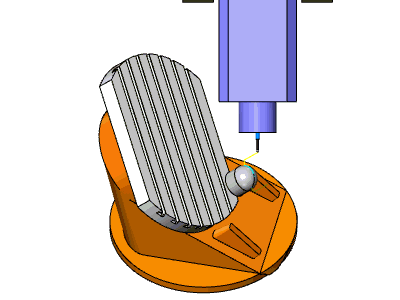
|
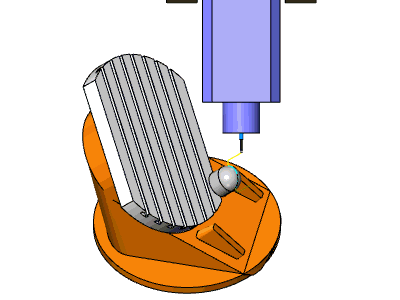
|
- Smooth Interpolation of Rotation Angle Around Pole - similar to Linear Interpolation, this option also manipulates the table rotation speed to create a more fluent transition.
| Without Smooth Interpolation | With Smooth Interpolation |

|

|
- Force
Table Rotation - uses table rotation moves instead of linear
moves when a multiaxis toolpath approaches 3-axis positioning.
- Pole
Angle Tolerance - controls how far from the main spindle
direction the tool axis can tilt and still be considered parallel,
in order to be used as a pole.
Tool Repositioning
In certain scenarios, when machine limits are reached, a retract move is needed. Tool Repositioning affects the retract move.
- Retract
Tool To Maximum
 Select the check box
to retract the tool to the maximum distance set for the machine.
Select the check box
to retract the tool to the maximum distance set for the machine. Clear the check box
to type a retract distance in the Tool Retract box.
Clear the check box
to type a retract distance in the Tool Retract box.- Tool Retract - type a value for the tool retract distance when the Retract Tool to Maximum check box is cleared.
Point Interpolation
- Interpolation
Type - select one of the two following options.
- By
Vectors - creates the interpolation between the two
endpoints of a toolpath segment in the shortest possible way.
The movement happens in a flat plane.
- By
Machine Angles - creates the interpolation between
the two endpoints of a toolpath segment gradually with respect
to the machine kinematics. The movement does not necessarily happen
in a flat plane.
- By
Vectors - creates the interpolation between the two
endpoints of a toolpath segment in the shortest possible way.
The movement happens in a flat plane.
Feed Move
- Max
Distance
 Clear the check box
to disable the Max Distance box.
Clear the check box
to disable the Max Distance box. Select the check box
to type a maximum distance value for feed moves for the selected interpolation
type.
Select the check box
to type a maximum distance value for feed moves for the selected interpolation
type. - Max
Angle
 Clear the check box
to disable the Max Angle box.
Clear the check box
to disable the Max Angle box. Select the check box
to type a maximum angle value for feed moves for the selected interpolation
type.
Select the check box
to type a maximum angle value for feed moves for the selected interpolation
type.
Rapid Move
- Max
Distance
 Clear the check box
to disable the Max Distance box.
Clear the check box
to disable the Max Distance box. Select the check box
to type a maximum distance value for rapid moves for the selected interpolation
type.
Select the check box
to type a maximum distance value for rapid moves for the selected interpolation
type. - Max
Angle
 Clear the check box
to disable the Max Angle box.
Clear the check box
to disable the Max Angle box. Select the check box
to type a maximum angle value for rapid moves for the selected interpolation
type.
Select the check box
to type a maximum angle value for rapid moves for the selected interpolation
type.
Retract and Rewind
Some machines have rotational limits that cannot be exceeded. In this situation, the machine must retract the tool and rewind the rotation axis to avoid exceeding the limits. The retract and rewind options determine how the machine handles exceeded rotation limits.
- Retract and Rewind
 Select the check box
to have the machine perform a retract and rewind move to avoid exceeding
rotational limits.
Select the check box
to have the machine perform a retract and rewind move to avoid exceeding
rotational limits. Clear the check box
if you don't want to generate a retract when the machine needs to rewind
(this may result in collisions depending on the part and machine).
Clear the check box
if you don't want to generate a retract when the machine needs to rewind
(this may result in collisions depending on the part and machine).- Angle
 Select the check box
to specify an angle step for the retract moves that are used with the
Retract and Rewind option. This determines the amount of rotation between
possible retract moves. A large value results in less moves and a smaller
value may result in more moves.
Select the check box
to specify an angle step for the retract moves that are used with the
Retract and Rewind option. This determines the amount of rotation between
possible retract moves. A large value results in less moves and a smaller
value may result in more moves. Clear the check box
to allow only a single retract position to be utilized for the retract
and rewind moves. All retract moves use the same location to move to clearance.
Clear the check box
to allow only a single retract position to be utilized for the retract
and rewind moves. All retract moves use the same location to move to clearance.
- Angle
Machine Definition Zero
-
 Real
Machine Zero - the posted NC program uses the actual machine zero
location.
Real
Machine Zero - the posted NC program uses the actual machine zero
location. -
 Work
Offset Position - the posted NC program uses the location
defined by the work offset.
Work
Offset Position - the posted NC program uses the location
defined by the work offset.
Move List Writer
The Move List Writer options control what appears in the posted NC program. These options are used to set machine limits that are not exceeded in the posted NC program. Some machines don't have rotational limits, and some don't except large angle values. You can limit the angle values used.
- 1st
Rot Axis Angle Limit - limits the values used for the first
rotational axis. Select: No Limits, Limit Between 0 and 360 degrees,
or Limit Between -180 and 180 degrees.
- 2nd Rot Axis Angle Limit
- limits the values used for the second rotational axis. Select: No
Limits, Limit Between 0 and 360 degrees, or Limit Between -180 and
180 degrees.
Move List Writer
The Move List Writer controls how the coordinates are output in the posted NC program.
- Standard - will dictate the output for any operation not under an index system, that is not a multiaxis feature operation. This will apply to wrapping groups as well.
- Indexing / Positioning - will dictate the output for any operation under an index system, that is not a multiaxis feature operation.
- Multiaxis Simultaneous Motion - will dictate the output for any mutiaxis feature operation, and includes 4 axis rotary toolpath.
For each of those sections, the following options are available:
- No Machine Compensation - The coordinates of the NC program will be the pure machine coordinates. Caution should be used here, as the 0,0,0 positions of your machine built in BobCAD must exactly match the real machine.
- Machine Compensation in Z Only - This mode is the most commonly used coordinate output mode, which aligns with the G43 tool length compensation mode. For 5 axis machining, the Machine Setup origin stays fixed relative to the machine, and the coordinates are all calculated from this position. The tool and holder total length are subtracted from the machine Z value in BobCAD.
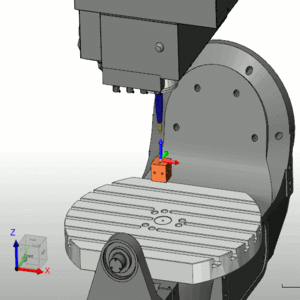
- Machine
Hybrid Compensation (Mixed Mode) - This mode is similar to the Machine Comp in Z, with the difference that the tool and holder length are subtracted from along the tool axis direction instead of just in Z. This is mode is typically only utilized by some 5 axis mill turn machines.
- Part
Based (Common for TCP) - The coordinates are output relative to the Machine Setup. In the case of 5 axis machining, as the part rotates on the machine, the coordinate system remains relative to the part and will rotate as the machine rotates the workpiece.

- Origin Tracking - This mode is similar to Part Based TCP output in where the Machine Setup origin stays relative to the part even as the machine rotates it rotary axes. The difference being that the orientation of the coordinate system does not change as the machine rotates. This mode is typically only used on machines where the rotations are at the table, for example with Haas DWO output.
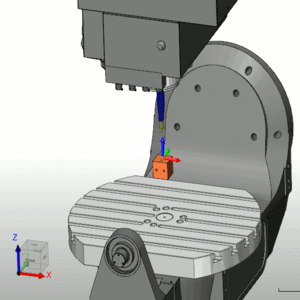
After Defining Current Settings
When you are finished with all Current Settings, click OK to save all of the settings with the selected machine. After you have defined all of your machines in the Current Settings Default, they are then available for all new CAM Jobs and can be selected per job from the Current Settings Job. To learn more, view the links listed next.
Related Topics
The Job Current Settings Dialog Box
